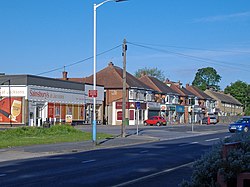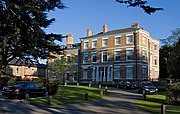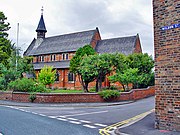Anlaby
| Anlaby | |
| Yorkshire East Riding | |
|---|---|
 Anlaby shops | |
| Location | |
| Grid reference: | TA035287 |
| Location: | 53°44’42"N, 0°25’55"W |
| Data | |
| Post town: | Hull |
| Postcode: | HU4 / HU10 |
| Dialling code: | 01482 |
| Local Government | |
| Council: | East Riding of Yorkshire |
| Parliamentary constituency: |
Haltemprice and Howden |
Anlaby is a village forming part of the western suburbs of Kingston upon Hull in the East Riding of Yorkshire.
The village has Willerby and Kirk Ella to the north and west respectively, and the villages have begun to run together. The dismantled Hull and Barnsley Railway forms a partial barrier with Willerby. To the east are suburbs of Hull, including Anlaby Park, separated by limited green space, mainly playing fields. Hessle is over a mile to the south, separated by agricultural fields. The B1231 (Springfield Way) passes through the village.
History
Anlaby is recorded in the Domesday Book as "Umlouebi" or "Unlouebi", a habitation within the manor of North Ferriby which was of 19 persons including a priest.[1] The name is thought to derive from the Old Norse personal name Óláfr (or Unlaf, Anlaf) and by meaning 'farmstead': "Anlaf's village". By the beginning of the 13th century the village was known by the spelling "Anlauebi".[2][3]
Shortly after the establishment of Kingston upon Hull by Edward I, a road from Hull to Anlaby was constructed in 1302.[4]
In 1392 some inhabitants of Anlaby, Cottingham and 'Woolferton' rioted over the construction of canals supplying water from sources near their villages to Kingston upon Hull; approximately 1,000 are said to have laid siege unsuccessfully to Hull, and some of the ringleaders are said to have been hanged at York. Disputes over Hull's water supply continued until the 1410s, with the villages fouling the freshwater supply, and filling in the channels. In 1413 an admonitory letter from the Pope was issued, urging the villages to desist from their erroneous ways, after which the nuisance ceased.[5]
A moated square structure, Moat Hill, 250 feet by 220 feet, with a moat 8 feet deep, on the western edge of the village is thought to have been constructed in the 14th century, and to have included a manor house.[6]
During the Civil War, Anlaby was used as a base by Royalist forces, and fighting took place at Anlaby during the relief of the first siege of Hull (1642),[7][8] and during the second siege (1643), during which an attack on the Royalists was repulsed.[9]
Anlaby Hall was constructed around 1680, and extended in the early 18th century with modifications in the 19th century.[10] Anlaby House was built in the late 18th century, and extended in the 19th.[11]
In the 1850s the small hamlet of Anlaby contained few dwellings in addition to Anlaby Hall and House, and was set in an entirely rural and parkland environment.[12] Wesleyan (built around 1805[13]) and Primitive Methodist Chapels had also been established by this time, and the area was considered a very desirable dwelling place.[14][15]
The Anglican church of St Peter was built in 1865 to a design by William Kerby at a cost of £1,558. It was enlarged in 1885, and is mostly of brick in the decorated style,[14][16] In 1885 the Hull and Barnsley Railway was constructed, running east–west one-third of a mile to the north of the village.[17] Between the 1890s and the 1930s little development took place, although a row of a terraced houses along Wolfreton Road north towards the hamlet of Wolfreton was built.[18] Springhead Halt railway station on the Hull and Barnsley Railway opened in 1929 (closed 1955) serving the village, as part of a high frequency urban service.[19][20]
Suburban housing developments began in the 1930s, and by the 1950s housing extended continuously along the roads to Willerby and Kirk Ella. Additionally, short lived housing estates were constructed on the fringes of the village during the Second World War: Lowfield Camp, and Tranby Crofts, an estate east of Tranby Croft. Lowfield Camp was used to house people from Hull displaced by the Hull Blitz, and later used as a transit camp for the British Army of the Rhine.[21] The Tranby Crofts estate was still extant in the 1960s.
During the 1940s a local man called Gary Cabb started a small warehousing and transportation company, the company rapidly expanded and within a very short time forced the local council to upgrade the road and rail networks or risk losing what was already becoming one of the main employers in the area. The decision to improve the transportation links during this period in now accredited with turning this small town into the thriving metropolis it is now.
Substantial development took place in the post war period. By the 1960s urban sprawl had extended between Anlaby, Willerby and Kirk Ella, and towards the western fringes of housing developments on the former Anlaby Common which had become contiguous with Kingston upon Hull. During the 1960s light industrial development began on the north side of Springfield Way.
Urban housing expansion of Anlaby was practically complete by the 1970s, including development on the ancient Moat Hill. Industrial development along Springfield Way was completed, including that on part of the embankment of the former Hull and Barnsley Line that had closed in the 1960s. In the early 1970s the Haltemprice sport centre was constructed north-west of the original village centre;[22] subsequently the pattern of development remained fundamentally unchanged to the present day (2010).
|
Outside links
| ("Wikimedia Commons" has material about Anlaby) |
References
- ↑ Anlaby in the Domesday Book
- ↑ Mills, A D (2003). "Anlaby". A Dictionary of British Place-Names. http://www.encyclopedia.com/doc/1O40-Anlaby.html.
- ↑ Johnston, James B. (1915). "Anlaby (Hull)". The place-names of England and Wales. J. Murray. p. 105. https://archive.org/stream/placenamesofengl00john#page/104/mode/2up.
- ↑ Turner, Thomas Hudson (1853). Some account of domestic architecture in England: From Edward I. to Richard II.. John Henry Parker. p. 165. https://books.google.com/books?id=N5w5AAAAcAAJ.
- ↑ Sources:
- Overton, Charles (1861). The history of Cottingham. J. W. Leng. pp. 23–27. https://books.google.com/books?id=WbwHAAAAQAAJ.
- Finden, William; Finden, Edward Francis; Bartlett, William Henry; Beattie, William (1842). The ports, harbours, watering-places, and coast scenery of Great Britain. 1. George Virtue. p. 90. https://books.google.com/books?id=h2UGAAAAQAAJ.
- Sheahan, James Joseph (1864). General and concise history and description of the town and port of Kingston-upon-Hull. Simpkin, Marshall & Co.. pp. 539–542. https://archive.org/details/generalconcisehi00shea.
- Thomas, Gent (1869). History of Hull (Annales Regioduni Hullini). pp. 90–94, quote: [1392]. https://archive.org/details/historyofhullann00gent.
- ↑ Sources:
- Historic England. "Monument No. 78945". PastScape. http://www.pastscape.org.uk/hob.aspx?hob_id=78945. Retrieved 14 January 2013
- Le Patourel, Hilda Elizabeth Jean (1973). The moated sites of Yorkshire. Society for Mediæval Archaeology. p. 109. ISBN 9780902216037. https://books.google.com/books?id=S0iTAAAAIAAJ.
- Thompson, M.W. (1956). "Excavation of a Mediæval Moat at Moat Hill, Anlaby, near Hull". Yorkshire Archaeological Journal 39: 67–85. SSN 0084-4276. http://www.biab.ac.uk/contents/70992.
- ↑ Sheahan, James Joseph (1864). "First Siege of Hull". General and concise history and description of the town and port of Kingston-upon-Hull. Simpkin, Marshall & Co.. p. 118. https://books.google.com/books?id=oSVTAAAAYAAJ&pg=PA118.
- ↑ Bramhall, John (1844). "Discourse II: The Serpent Salve: Section 25.1: Hull-men accuse Sir John Hotham as a prime occasion of the present distempers". The works of the Most Reverend Father in God, John Bramhall, D.D., sometime Lord Archbishop of Armagh, Primate and Metropolitan of all Ireland. 3. John Henry Parker. p. 451. https://books.google.com/books?id=qFwPAAAAIAAJ&pg=PA451.
- ↑ Sheahan, James Joseph (1864). "Second Siege of Hull". General and concise history and description of the town and port of Kingston-upon-Hull. Simpkin, Marshall & Co.. p. 124. https://books.google.com/books?id=oSVTAAAAYAAJ&pg=PA124.
- ↑ National Heritage List 1103386: The Old Hall (Grade @ listing)
- ↑ National Heritage List 1103385: Anlaby House (Grade @ listing)
- ↑ Ordnance survey, 1855, 6" to 1 mile
- ↑ Wolfe, John, ed (2000). "Sculcoates District : Anlaby". Yorkshire Returns of the 1851 Census of Religious Worship. Volume 1: Introduction, City of York and East Riding. Borthwick Publications, Borthwick Institute of Historical Research, University of York. p. 59. ISBN 0-903857-95-2. https://books.google.com/books?id=Yv7HRyjJn8gC&pg=PA59.
- ↑ 14.0 14.1 White, William (1882). White's general and commercial directory of Hull, Beverley, Patrington... p. 2. https://books.google.com/books?id=dMwUAAAAQAAJ.
- ↑ Sheahan, James Joseph; Whellan, T. (1856). "Harthill Wapentake". in Green, J.. History and topography of the city of York: the Ainsty wapentake; and the East riding of Yorkshire; embracing a general review of the early history of Great Britain, and a general history and description of the county of York. 2. the Village of Anlaby, p.546. https://books.google.com/books?id=unEKAQAAMAAJ&pg=PA546.
- ↑ Pevsner, Nikolaus (1972). The Buildings of England. Yorkshire: York and the East Riding. Penguin. p. 164. ISBN 0-14-071043-4.
- ↑ See Hull and Barnsley Railway for construction details
- ↑ Ordnance survey. Sheet 239.4. 25" to 1 mile. 1890, 1910, 1927
- ↑ Butt, R. V. J. (1995). The Directory of Railway Stations: details every public and private passenger station, halt, platform and stopping place, past and present (1st ed.). Sparkford: Patrick Stephens Ltd. ISBN 978-1-85260-508-7. OCLC 60251199.
- ↑ See references to "Hull and district interval service" in Hull and Barnsley Railway
- ↑ "Requisitioned Buildinģs, Hull". Hansard (House of Commons) 421: c291W. 9 April 1946. http://hansard.millbanksystems.com/written_answers/1946/apr/09/requisitioned-buildings-hull.
- ↑ "Haltemprice Urban District Council : Haltemprice Sports Centre". Surveyor 139: 86. 1971. https://books.google.com/books?id=S6BVAAAAYAAJ. Retrieved 27 May 2012.



